
Each year when the legislature gavels in for its regular session, there’s no doubt you’ll see a multitude of bills filed to trigger a constitutional convention. Those bills range from a convention that provides a full revision of the Louisiana State Constitution to a convention to make partial revisions to specific parts of the constitution such as the tax code and education. Ninety percent of the efforts to call a constitutional convention are backed by the business lobby. The business lobby has its fingers in every aspect of education in Louisiana. Have you ever wondered why they would have an interest in revising the education part of the constitution? I believe I know why.
 The Louisiana Constitutional Convention of 1974 produced a new working legal document on which the legislature is delegated the responsibility of creating and enacting laws. As I’ve written before, Article VIII, the Education Article of the state constitution, was the only article that was put to a popular vote with a plan A and a plan B because the delegates couldn’t agree on the final outcome. Article VIII, as voted by the electorate, established the framework for our current education system in Louisiana. Since that time, a few parts have been amended.
The Louisiana Constitutional Convention of 1974 produced a new working legal document on which the legislature is delegated the responsibility of creating and enacting laws. As I’ve written before, Article VIII, the Education Article of the state constitution, was the only article that was put to a popular vote with a plan A and a plan B because the delegates couldn’t agree on the final outcome. Article VIII, as voted by the electorate, established the framework for our current education system in Louisiana. Since that time, a few parts have been amended.
One of the most important parts of Article VIII is the State’s expressed intent to guarantee a minimum acceptable amount of spending per pupil for every student enrolled in public schools across the state. The program is called the Minimum Foundation Program, and its intent is to provide equitable, as opposed to equal, funding to every school district. In the following paragraphs, I will explain how this works and provide a timeline of some important events.
 Minimum Foundation Program (MFP)
Minimum Foundation Program (MFP)
The Louisiana Constitution delegates the responsibility of creating a formula to fund public education to BESE. The process of doing this involves two separate calculations. BESE must first determine the cost per pupil to educate all students enrolled in public schools. This is referred to as the “cost side” of the MFP. It is a complex series of weighted values related to different types of students and other factors. The cost side of the MFP is tweaked every now and then to make adjustments to funding. BESE has authority to do this because determining the formula is BESE’s responsibility.
The other calculation that BESE is tasked with is the “support side.” This portion of the MFP calculation is defined in the constitution. Through uniform reporting from individual districts, BESE determines each district’s ability to support the MFP cost formula via “ad valorem” taxes, or property taxes. The constitution gives authority to school districts to levy a 5 mill property taxes, for this purpose. The amount of money raised via the constitutional millage is subtracted from the “cost per pupil,” and the remainder is the state portion of the MFP for that district. This assures that even the poorest districts are able to fund at the minimum level because the state will fund the majority of their MFP. Seventy percent of the money derived from this formula must be spent on direct classroom expenses. The constitution also gives districts the authority to levy additional property taxes to fund specific items. (Click here to see the Constitutional Article)
In the local government article of the constitution, districts are given the authority to levy up to 3% sales taxes to facilitate a district’s ability to fund its district “above” the minimum foundation determined by BESE. (Click here to see the Constitutional Article) When the legislature enacted new laws under the new state constitution, it expressly prohibited the use of sales taxes imposed by a school board in the calculation of the support side of the MFP. (Click here to read the statute)
 First Legal Challenge
First Legal Challenge
In 1986, less than ten years after the new constitution was in place, thirteen of the poorest parishes joined together in a lawsuit challenging BESE’s MFP formula arguing that local sales taxes should be included in the formula, because richer districts were able to generate more additional funding with their ability to levy a 3% tax; therefore, the formula created inequities in funding from parish to parish. The district courts ruled against them saying that the formula accomplishes what the constitution intended. The plaintiffs appealed to the 5th Circuit Court of Appeals where the case was dismissed. The case was appealed to the Louisiana Supreme Court where it was remanded to the appellate court and denied, again. Below is an excerpt from the ruling.
” Thus, while the supply side of the BESE equalization formula produces a local contribution that may reflect relative school district wealth less than if it also accounted for inter-district differences in sales tax, bond, and sixteenth-section land revenues, the formula is not without some substantial equalizing effect. We find that the MFP formula’s equalization factor does not violate the equal protection clause.”
In 1997, another suit was filed to challenge the formula set forth by BESE. The suit, like the first one, was dismissed by the appellate courts, appealed to the supreme court, then remanded to the appellate court where it was upheld and died. The petitioners essentially made the same argument alleging that the formula created inequities, rather than eliminating inequities. They cited the exclusion of local sales taxes, the legislature’s ability to arbitrarily reduce appropriations, and several other things. During the testimony, Marilyn Langley (LDOE Deputy Supt. of Finance) testified that changes had been made to the 1992 MFP formula that went into effect in the 1993 MFP that addressed the inequities that the plaintiffs were asserting. As a result, the courts found the arguments moot, thus the case was dismissed.
Changes to the MFP Formula
What exactly were those changes to the MFP formula that Mrs. Langley referred to? In the 1991 legislative session, a resolution was passed creating an MFP task force to study the MFP formula and make recommendations to the legislature for drafting legislation. At the conclusion of the study, a number of recommendations were made. Some recommendations were directly to BESE for consideration in creation of the formula, and others were to the legislature for changes in law that would affect funding the MFP. One of the organizations represented in the study was the Public Affairs Research Council of Louisiana (PAR). Among the final recommendations were the following items that were pushed by PAR. (Click here to see PAR publication)
- Reduce Homestead Exemptions from $75,000 to $25,000 citing that business and industry bears the weight of 95% of property tax collections, and the burden of supporting local schools should be shared by the homeowners in the community. (legislature)
- Repeal the statute that prohibits the use of sales tax collections in the support side of the MFP formula. (legislature)
- Revise the MFP formula to include local sales tax collections levied by local school boards. (BESE)
In the 1992 legislative session, the legislature failed to reduce the homestead exemption. They also failed to repeal the statute prohibiting the use of sales taxes in the MFP. The statute is still in effect. Despite neither of these legislative actions taking place, in the 1992 legislative session, BESE presented a formula to the legislature that included local sales taxes. The formula was accepted by the legislature via SCR-223, and for every year since 1992 (26 years) an MFP formula that included local sales tax collections has been presented and approved by the legislature in direct conflict with the Louisiana Constitution and Louisiana Revised Statutes. (Click here to see SCR-223)
“The formula was accepted by the legislature via SCR-223, and for every year since 1992 (26 years) an MFP formula that included local sales tax collections has been presented and approved by the legislature in direct conflict with the Louisiana Constitution and Louisiana Revised Statutes.”
 Now that you know that BESE has illegally calculated sales tax in the MFP, it is a little easier to understand why the business lobby has continuously pushed for a limited convention that includes Article VIII. When word got out to districts that a new formula was being implemented, they scrambled to pass new sales taxes to increase local revenue in the event their portion of MFP was reduced by the new formula. Little did they know that the new formula considered sales taxes, including the new ones they were passing. The business lobby knew what was going on, though.
Now that you know that BESE has illegally calculated sales tax in the MFP, it is a little easier to understand why the business lobby has continuously pushed for a limited convention that includes Article VIII. When word got out to districts that a new formula was being implemented, they scrambled to pass new sales taxes to increase local revenue in the event their portion of MFP was reduced by the new formula. Little did they know that the new formula considered sales taxes, including the new ones they were passing. The business lobby knew what was going on, though.
The business lobby is who was pushing for homestead exemptions to be reduced to shift property tax burdens to homeowners. That didn’t happen. Can you guess what did happen within a few years of the new formula being enacted? Applications to the Industrial Tax Exemption Program (ITEP) began receiving approvals at an unprecedented rate shifting all of the burden of local support of the MFP to homeowners and sales tax revenue in the richest parishes. This is also why you’ll find the business lobby coming out in favor of small new sales taxes to support teacher raises. These raise the overall local support of the MFP while masking the overall reduction in ad valorem tax revenues.
Again, none of this is within the law. This needs to be challenged in a court of law.

